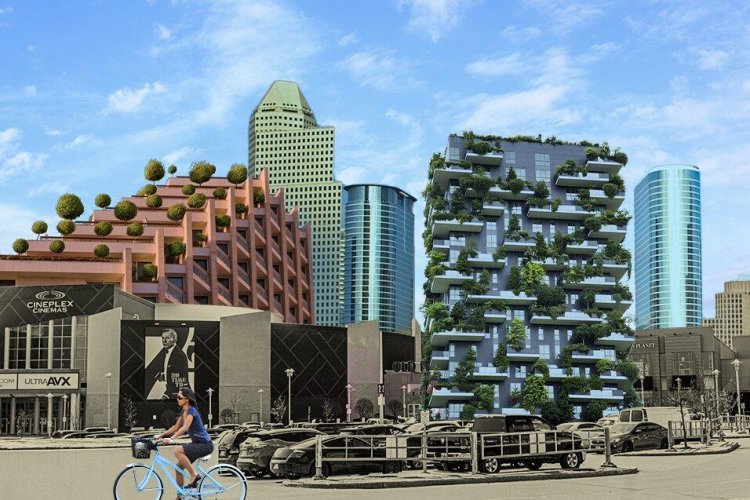Is the shopping mall already dead? How surprising new plans for centres ranging from Yorkdale to Square One will redefine the mall as we know it
Malls are in trouble. They have been for years. The reflective marble-like floors, the predictable middle-tier retailers and the cut-and-paste food courts have lost their shine for many consumers, and leading up to the COVID-19 pandemic, the companies that own them were already trying to figure out how to pivot and succeed. As has been the case with many trends, the pandemic sped up this process. Retailers that had been struggling to remain relevant gave up, filing for bankruptcy. Longtime anchor tenants started to rethink their brick-and-mortar footprints, e-commerce bloomed, and office workers migrated en masse to the suburbs, while businesses downtown wondered if they’d ever return (spoiler alert: probably not).Many of the GTA’s malls were already on track to undergo big changes in the coming years. Some of the largest, such as Yorkdale and Square One, are slated for redevelopment — many will soon be surrounded by condo towers and public parks, some will be partially or fully destroyed. Inside these malls, experts predict an expanding array of services, medical offices, entertainment venues and fulfilment centres.Some of the planned projects — which are so far mainly in the form of brightly coloured renderings — will pan out, others likely won’t. But one thing seems certain.The mall of the future might not be a mall at all.Doug Stephens, founder of consulting firm Retail Prophet, said in the decades leading up to the 21st century, there was a proliferation of malls and shopping centres in North America, “the likes of which we never saw prior, and are likely never to see again.”“The shopping centre was an analog form of the internet,” he said — it was where you met friends, went shopping, picked up concert tickets, bought CDs.But in a relatively short time period, all that has changed, said Stephens. Shopping, music, tickets, socialization — these can all be done online. Consumers have fewer reasons to enter a shopping mall, and so do retailers.Foot traffic in Canada’s top 10 malls was down 42 per cent in February 2020 compared to a year earlier, a report by Deloitte found, and that was before the pandemic hit.“I think what we have seen is an undoing of that fundamental role of the shopping centre in our lives,” Stephens said. In some cases, that undoing is quite literal. The first “de-malling” in Canada took place at Edmonton’s Heritage Mall, a relatively short-lived shopping centre resplendent with palm trees imported from Florida and a water feature, said Jane Domenico, senior vice-president and national lead of retail services for Colliers Canada. It closed after two decades in 2001 and was demolished around five years later. Predictably, de-malling was much more widespread in the U.S., said Domenico, where retail spaces per capita were bloated and many old malls were thrown to the wayside. Canada had been much more conservative in its mall-building; when Vaughan Mills was built, it was the first new enclosed mall in Canada to be built in around 14 years, she said.But de-malling here seems to be picking up speed — one only has to look at the glut of planned redevelopments in the GTA alone to see that malls, writ large, will not look the same by the end of this decade. De-malling encompasses a variety of approaches, including the complete destruction of a mall, like Heritage, or a partial teardown, perhaps a specific wing that once housed an anchor tenant.Marty Weintraub, national leader for Deloitte’s retail consulting practice for Canada, knew when the pandemic hit that something fundamental was going to happen to the retail sector. The notion of a traditional shopping mall was already shifting, and the long-standing anchor tenants were becoming obsolete. Foot traffic in Canadian malls had been dropping for two years when the pandemic began. E-commerce was creeping in. Malls, with their shiny off-white sameness, were boring.When COVID-19 struck, many retailers that were already struggling hit a wall, Domenico said, and there was an early wave of bankruptcies and restructuring filings among companies like Reitmans and Le Château that signalled the beginning of the end of retail as we know it. The next few years will be critical for malls, said Andrew Gallici, director of retail design at design and architecture firm Gensler, as developers and retailers have conversations not unlike those being had by tenants and leasers of downtown office buildings.Malls will increasingly be curated, he said, representing a particular point of view and reflecting the community around them — a direct challenge to the cut-and-paste nature of pre-pandemic malls. COVID-19 broke off the shackles, said Weintraub. It culled the retailers that had been on the way out, separating the wheat from the chaff.“It was the last nail in the coffin.”“In shopping malls … there’s tremendous transformation happening,” said Michael LeBlanc, senior adviser to the Retail Council of Canada. The forces driving this, both e-commerce and hybrid


Malls are in trouble.
They have been for years. The reflective marble-like floors, the predictable middle-tier retailers and the cut-and-paste food courts have lost their shine for many consumers, and leading up to the COVID-19 pandemic, the companies that own them were already trying to figure out how to pivot and succeed.
As has been the case with many trends, the pandemic sped up this process. Retailers that had been struggling to remain relevant gave up, filing for bankruptcy. Longtime anchor tenants started to rethink their brick-and-mortar footprints, e-commerce bloomed, and office workers migrated en masse to the suburbs, while businesses downtown wondered if they’d ever return (spoiler alert: probably not).
Many of the GTA’s malls were already on track to undergo big changes in the coming years. Some of the largest, such as Yorkdale and Square One, are slated for redevelopment — many will soon be surrounded by condo towers and public parks, some will be partially or fully destroyed. Inside these malls, experts predict an expanding array of services, medical offices, entertainment venues and fulfilment centres.
Some of the planned projects — which are so far mainly in the form of brightly coloured renderings — will pan out, others likely won’t. But one thing seems certain.
The mall of the future might not be a mall at all.
Doug Stephens, founder of consulting firm Retail Prophet, said in the decades leading up to the 21st century, there was a proliferation of malls and shopping centres in North America, “the likes of which we never saw prior, and are likely never to see again.”
“The shopping centre was an analog form of the internet,” he said — it was where you met friends, went shopping, picked up concert tickets, bought CDs.
But in a relatively short time period, all that has changed, said Stephens. Shopping, music, tickets, socialization — these can all be done online. Consumers have fewer reasons to enter a shopping mall, and so do retailers.
Foot traffic in Canada’s top 10 malls was down 42 per cent in February 2020 compared to a year earlier, a report by Deloitte found, and that was before the pandemic hit.
“I think what we have seen is an undoing of that fundamental role of the shopping centre in our lives,” Stephens said.
In some cases, that undoing is quite literal.
The first “de-malling” in Canada took place at Edmonton’s Heritage Mall, a relatively short-lived shopping centre resplendent with palm trees imported from Florida and a water feature, said Jane Domenico, senior vice-president and national lead of retail services for Colliers Canada. It closed after two decades in 2001 and was demolished around five years later.
Predictably, de-malling was much more widespread in the U.S., said Domenico, where retail spaces per capita were bloated and many old malls were thrown to the wayside. Canada had been much more conservative in its mall-building; when Vaughan Mills was built, it was the first new enclosed mall in Canada to be built in around 14 years, she said.
But de-malling here seems to be picking up speed — one only has to look at the glut of planned redevelopments in the GTA alone to see that malls, writ large, will not look the same by the end of this decade.
De-malling encompasses a variety of approaches, including the complete destruction of a mall, like Heritage, or a partial teardown, perhaps a specific wing that once housed an anchor tenant.
Marty Weintraub, national leader for Deloitte’s retail consulting practice for Canada, knew when the pandemic hit that something fundamental was going to happen to the retail sector.
The notion of a traditional shopping mall was already shifting, and the long-standing anchor tenants were becoming obsolete. Foot traffic in Canadian malls had been dropping for two years when the pandemic began. E-commerce was creeping in. Malls, with their shiny off-white sameness, were boring.
When COVID-19 struck, many retailers that were already struggling hit a wall, Domenico said, and there was an early wave of bankruptcies and restructuring filings among companies like Reitmans and Le Château that signalled the beginning of the end of retail as we know it.
The next few years will be critical for malls, said Andrew Gallici, director of retail design at design and architecture firm Gensler, as developers and retailers have conversations not unlike those being had by tenants and leasers of downtown office buildings.
Malls will increasingly be curated, he said, representing a particular point of view and reflecting the community around them — a direct challenge to the cut-and-paste nature of pre-pandemic malls.
COVID-19 broke off the shackles, said Weintraub. It culled the retailers that had been on the way out, separating the wheat from the chaff.
“It was the last nail in the coffin.”
“In shopping malls … there’s tremendous transformation happening,” said Michael LeBlanc, senior adviser to the Retail Council of Canada.
The forces driving this, both e-commerce and hybrid work, are giving new life to many malls outside the downtown core that service large suburban areas.
These malls are experimenting with format, experience and variety, LeBlanc said, as are the tenants that inhabit them. And even digitally native brands are realizing that a physical store has value, even if its purpose is not solely to create more sales.
Toronto-based retail analyst and author Bruce Winder describes an increasing polarization happening before the pandemic, between the luxury or A-Class malls like Yorkdale and the Eaton Centre and the rest of the pack.
The former were getting stronger, bringing on international brands and focusing more on experience, said Winder, such as luxury services, valet parking and expanded food options.
But with the traditional anchor retailers either closing altogether — Zellers, Target, Sears — or shrinking their brick-and-mortar footprint like Hudson’s Bay, those middle malls and those below them were reaching a tipping point, said Winder.
“You started to see a fair amount of closures in these middle-tier malls. And they were scrambling to try to repurpose them.”
With consumers gravitating toward experience rather than solely retail, some malls will be left behind, said LeBlanc.
“There will always be different malls at different tiers. I don’t think the format, or the way we classify them, is going to change,” said LeBlanc. “But I do think the future is different for different classifications of malls.”
The high-end malls will continue to be destinations, and the middle-tier malls have gotten a breath of fresh air from the pandemic, LeBlanc said, with more workers flocking to the suburbs. But many regional and community malls will continue to struggle. “They need to reinvent themselves, and it may not be possible to reinvent all the way back up to relevance.”
With the rise in e-commerce came a need for warehouse or fulfilment space, said Winder, which woke up many major retailers as that space came at a premium. That’s why retailers are increasingly using their retail spaces for order fulfilment, and in some malls Winder predicts we may even see “dark stores” used exclusively for order fulfilment and shipping.
But for many retailers, e-commerce isn’t battling brick-and-mortar sales, said Domenico. Instead, e-commerce is like an expansion of the brick-and-mortar store — and studies have shown that if retailers can get online shoppers to pick their wares up in person, there’s a high likelihood they’ll pick up something else while they’re there.
In a survey sampling Colliers Canada’s Real Estate Management Services retail tenants published in January, around 55 per cent said they are using their stores to fulfil customers’ online orders. The number of businesses with an e-commerce platform doubled since COVID-19 began, even though only seven per cent said their online sales are more profitable than in-store.
So what will become of the spaces left by retailers that didn’t make the COVID-19 cut?
Retail analyst Lisa Hutcheson, a managing partner at consulting firm J.C. Williams Group, said malls will become more local and community-focused.
“They’re sort of moving toward this 15-minute city,” she explained, where everything you need is close by, whether you’re living in an urban or suburban area. This is a concept that has been accelerated by remote and hybrid working, she added — when people aren’t travelling to the downtown core five days a week, they look for certain amenities and retailers closer to home.
That means an increased mix of necessity tenants like grocery stores and medical offices in suburban malls, especially with the move toward residential developments around shopping centres, Domenico said, while downtown malls like the Eaton Centre might double down on being a shopping destination.
The idea of a “live, work, play” neighbourhood, an amalgam of shiny condo towers, bright green spaces and office buildings, has been in the public imagination for years, said Domenico. Retail sites in Canada are large and well-situated, and so developers and owners are looking at those swaths of concrete and trying to come up with the best possible use for those assets.
And in the GTA alone, several malls are slated for redevelopment of some kind — Centrepoint, Yorkdale, Sherway Gardens and Square One, to name a few. Each is slightly different, but the plans all have something in common: a mixture of condo towers, green space and other buildings, melded together into what the developers hope will become a community.
These developments exist on a spectrum, said Domenico: some, like Centerpoint, will get rid of the existing mall entirely. Others, like Yorkdale, will leave the mall intact and build around it. And many will fall somewhere in the middle, perhaps de-malling part of the existing structure or using it for other purposes.
But do people really want to live next to a mall?
Maybe not the malls of today, said Stephens. “The shopping centre, as we know it today, is a relatively sterile and antiseptic environment, let’s face it,” he said. But the mall of the future should cater to those residents, offering food, entertainment, services, markets and more. “The onus now is on shopping centre developers to create that amazing stuff.”
Gensler’s Gallici agrees. “We want a paradigm-shifting kind of understanding of what people are seeking when they’re looking for neighbourhood,” he said. “Neighbourhood isn’t just a bunch of condos stacked on top of a mall.”
While many of these developments are years away from completion, there are a few shopping centres in Canada that are great examples of what the future could hold, said Hutcheson, such as Brentwood Town Centre in Burnaby, B.C., a.k.a. “The Amazing Brentwood,” a mix of retailers, office space and residential towers. These developments are often planned around a transit station, like Brentwood, and are increasing their entertainment and food offerings to draw people in.
These changes are all part of the effort to “future proof” the mall, she said.
Because of these shifts, the metrics long used to measure the success of a shopping centre are also changing, said Hutcheson. Sales per square foot used to be king, but with the integration of e-commerce and in-person shopping, she anticipates new metrics will be tested in the years to come.
But at what point does the mall change so much that it’s no longer a mall?
“I think the definition of a mall is outdated,” said Winder. “It’s a legacy term that’s from a different time.”
Many suburban malls will become hubs, or marketplaces, influenced by the people who rely on them daily. The mall as we know it may not be dead, but the so-called golden age of malls, the malls of the 1980s up to the early 2000s, is over.
“It’s just changing with people’s wants and needs,” said Domenico. “I call it the new mall.”
Rosa Saba is a Toronto-based business reporter for the Star. Follow her on Twitter: @rosajsaba



















:quality(85):upscale()/2024/08/26/163/n/1922283/64d5eb8566cd4005122c30.42614493_.jpg)
